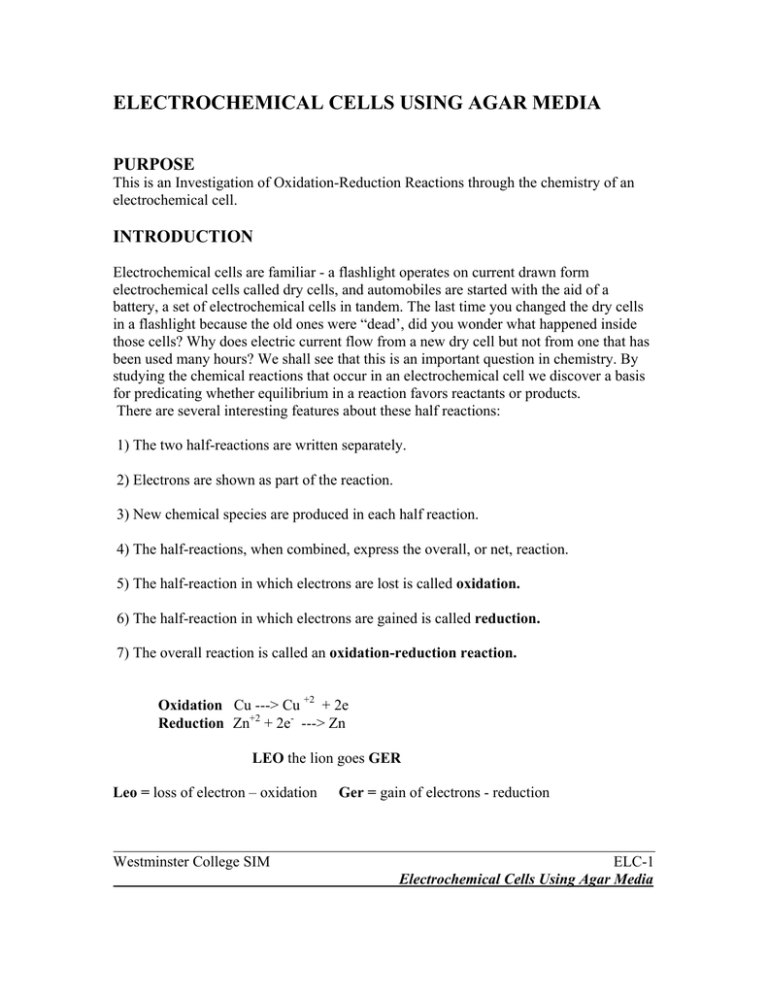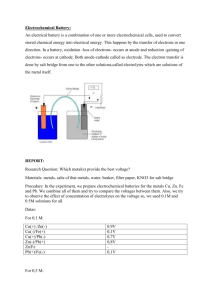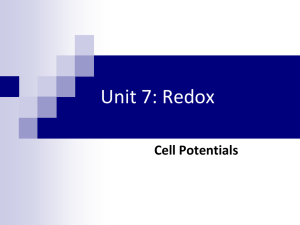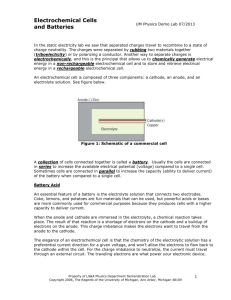ELECTROCHEMICAL CELLS USING AGAR MEDIA PURPOSE
advertisement

ELECTROCHEMICAL CELLS USING AGAR MEDIA PURPOSE This is an Investigation of Oxidation-Reduction Reactions through the chemistry of an electrochemical cell. INTRODUCTION Electrochemical cells are familiar - a flashlight operates on current drawn form electrochemical cells called dry cells, and automobiles are started with the aid of a battery, a set of electrochemical cells in tandem. The last time you changed the dry cells in a flashlight because the old ones were “dead’, did you wonder what happened inside those cells? Why does electric current flow from a new dry cell but not from one that has been used many hours? We shall see that this is an important question in chemistry. By studying the chemical reactions that occur in an electrochemical cell we discover a basis for predicating whether equilibrium in a reaction favors reactants or products. There are several interesting features about these half reactions: 1) The two half-reactions are written separately. 2) Electrons are shown as part of the reaction. 3) New chemical species are produced in each half reaction. 4) The half-reactions, when combined, express the overall, or net, reaction. 5) The half-reaction in which electrons are lost is called oxidation. 6) The half-reaction in which electrons are gained is called reduction. 7) The overall reaction is called an oxidation-reduction reaction. Oxidation Cu ---> Cu +2 + 2e Reduction Zn+2 + 2e- ---> Zn LEO the lion goes GER Leo = loss of electron – oxidation Westminster College SIM Ger = gain of electrons - reduction ELC-1 Electrochemical Cells Using Agar Media PROCEDURE 1. Add three drops of 0.1 M NaCl to a strip of paper and place it so that a bridge is formed between the surfaces of two of the individual cells. 2. Insert a copper strip into the CuSO4 /agar media. By selecting two half cells to be coupled together in this manner an electrochemical cell that is a galvanic or voltaic cell is formed. Other cell arrangements can be made using the NiSO4/agar media and the MgSO4/agar media. 3,Set up the Lab Pro to read voltage. Connect the voltage probe to the cell and measure the cell potential. The zinc electrode is cathodic and the copper electrode is anodic. 4. Put together the cell combinations indicated on the data sheet, measure the experimental potentials (volts), and determine the cell efficiency for each arrangement. GIVEN: E0 = (E01) – (E02) OXIDIZED STATE Mg++ + 2e ÅÆ REDUCED STATE Mg0 E0 (volts) +2.37 Zn++ + 2e ÅÆ Zn0 +0.76 Ni++ + 2e ÅÆ Ni0 +0.25 Cu++ + 2e ÅÆ Cu0 -0.34 Westminster College SIM ELC-2 Electrochemical Gels Using Agar Media STUDENT DATA SHEET Name (s): _____________________ _____________________ Date: _____________________ Cell Operation and Efficiency Determinations: Measured Calculated Cell Potential (volts) Potential (volts) Efficiency (%)* Cell copper/zinc copper/nickel copper/magnesium nickel/magnesium nickel/zinc *Cell efficiency (%) = experimental voltage X 100 Calculated voltage Westminster College SIM ELC-3 Electrochemical Gels Using Agar Media DISCUSSION 1.Sketch and label the arrangement of the cell parts as the cell is ready for operation. 2. It is possible that your experimental cell voltage is not the same as the theoretical or accepted value. Discuss at least two reasons for this occurrence. 3. Discuss how and why the electrons move in these cells. 4. How would you change the arrangement of the cell to make it a electrolytic cell? References Gel Cels, Instructor’s Manual by T& S Educational, Inc. Cells, Gels and the Enzymes of Life, F. H. Pallock, May 2001 Biochemistry, Cell & Molecular Biology, J. Rudman, 1999 A Beginners Guide to Blood Cells, B.J. Bain, 1996 Westminster College SIM ELC-4





